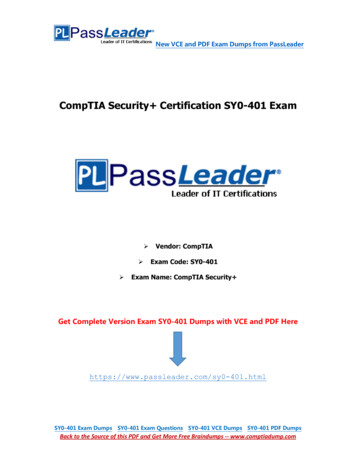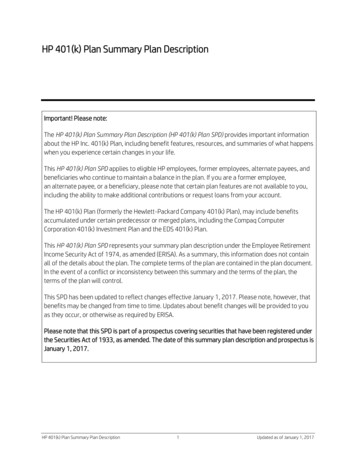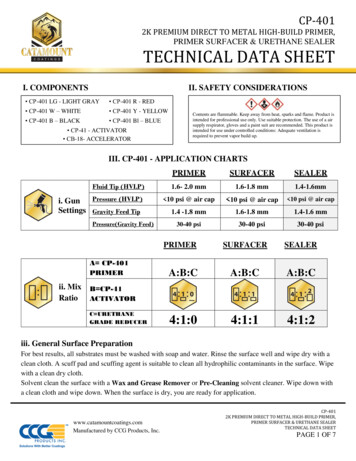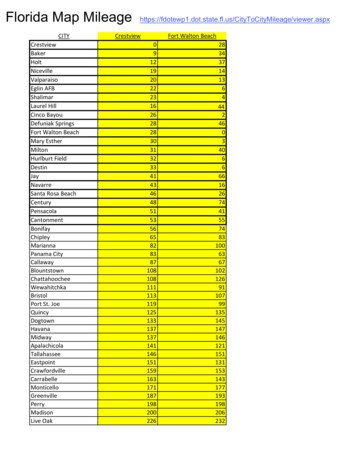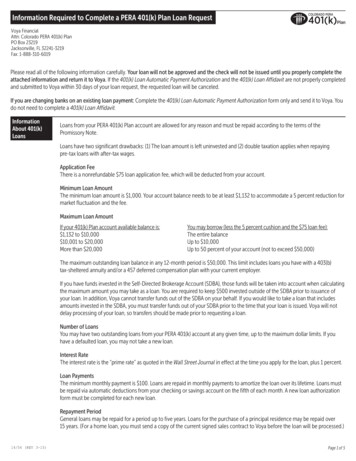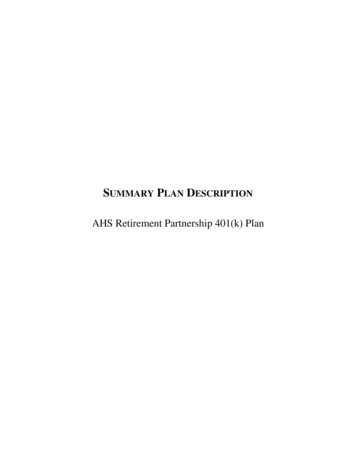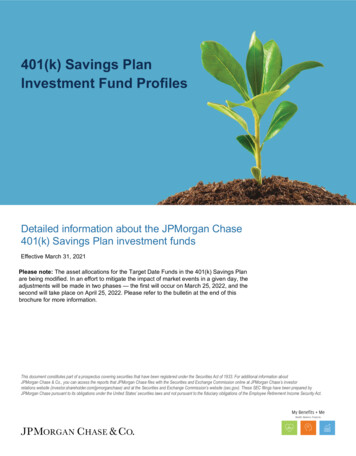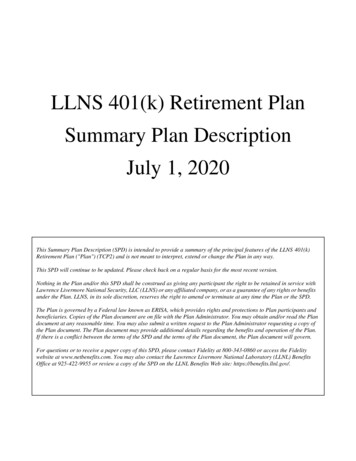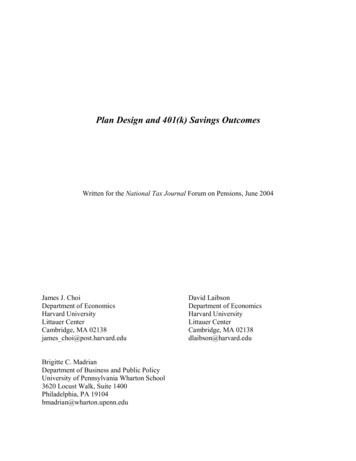
Transcription
Plan Design and 401(k) Savings OutcomesWritten for the National Tax Journal Forum on Pensions, June 2004James J. ChoiDepartment of EconomicsHarvard UniversityLittauer CenterCambridge, MA 02138james choi@post.harvard.eduBrigitte C. MadrianDepartment of Business and Public PolicyUniversity of Pennsylvania Wharton School3620 Locust Walk, Suite 1400Philadelphia, PA 19104bmadrian@wharton.upenn.eduDavid LaibsonDepartment of EconomicsHarvard UniversityLittauer CenterCambridge, MA 02138dlaibson@harvard.edu
Abstract: We assess the impact of 401(k) plan design on four different 401(k) savings outcomes:participation in the 401(k) plan, the distribution of employee contribution rates, asset allocation,and cash distributions. We show that plan design can have an important effect on all of thesesavings outcomes. This suggests an important role for both employers in determining how tostructure their 401(k) plans and government regulators in creating institutions that encourage ordiscourage particular aspects of 401(k) plan design.I. IntroductionOver the last 20 years, defined contribution pension plans have gradually replaced definedbenefit pension plans as the primary privately-sponsored vehicle to provide retirement income.At year-end 2000, employers sponsored over 325,000 401(k) plans with more than 42 millionactive participants and 1.8 trillion in assets (Employee Benefit Research Institute 2000).Because of the favorable tax benefits afforded to saving through employer sponsored pensionplans, it is important to understand how these plans actually affect the “desired” outcomes forwhich the tax benefits are given.1The growth of 401(k)-type savings plans and the associated displacement of defined benefitplans has generated concerns about the adequacy of employee retirement savings. Definedcontribution pension plans place the burden of ensuring adequate retirement savings squarely onthe backs of individual employees. However, employers make many decisions about the designof 401(k) plans that can either facilitate or hinder their employees’ retirement savings prospects.Although the government places some limits on how companies can structure their 401(k) plans,employers nonetheless have broad discretion in the design of their 401(k) plans.Making good plan design decisions requires an understanding of the relationship betweenplan rules and participant savings outcomes. In this paper, we assess the impact of 401(k) plandesign on four different 401(k) savings outcomes: participation in the 401(k) plan, thedistribution of employee contribution rates, asset allocation, and cash distributions. We show thatplan design can have an important effect on all of these different savings outcomes. Thissuggests an important role for both employers in determining how to structure their 401(k) plansand government regulators in creating institutions that encourage or discourage particular aspectsof 401(k) plan design.1The annual tax expenditure association with employer-provided pension plans is estimated at 116 billion in 2004,about equally split between defined benefit and 401(k) plans (Employee Benefit Research Institute 2004).2
II. Plan Design and 401(k) ParticipationThe 401(k) plan is only a useful tool for helping employees save for retirement to the extentthat employees actually participate in their employer-sponsored 401(k) plan. Recent researchsuggests that when it comes to participation in the 401(k) plan, the key behavioral question is notwhether or not employees participate in the 401(k) plan, but how long it takes before employeesare actually enrolled, and the enrollment protocol adopted by the firm is a significant determinantin the answer to this question.Automatic Enrollment and 401(k) ParticipationIn most companies, the 401(k) plan requires an active election on the part of employees toinitiate participation. That is, if the employee does nothing, the default is that the employee willnot be enrolled in the 401(k) plan. Because this is the most widely used 401(k) enrollmentprotocol, we term this the “standard enrollment” approach to 401(K) participation. An alternativebut less widely used approach is to automatically enroll employees in the 401(k) plan, requiringan active election on the part of employees in order to opt out of 401(k) participation.2To examine the impact of automatic enrollment on 401(k) participation, we analyze theadministrative data on 401(k) participation at three large companies that adopted automaticenrollment during the 1990s. Table 1 gives some basic characteristics (industry, firm size) onthese and other companies analyzed in this paper.Figure 1, extending the analysis in Choi et al. (2002) and (2004), shows the dramatic impactthat the choice between these two different 401(k) enrollment protocols has on 401(k)participation for three different companies that switched from a standard enrollment regime toautomatic enrollment between 1997 and 1998.3,4 Under a standard enrollment regime, 401(k)participation is low initially and increases with employee tenure at a decreasing rate. Underautomatic enrollment, however, participation jumps to between 86% and 96% of employees onceit takes effect (between one and two months after hire in these companies) and increases onlyslightly thereafter. At low levels of tenure, the difference in participation rates under the standard2In a recent survey, Hewitt Associates (2001) reports that 14 percent of companies utilized automatic enrollment in2001, up from 7 percent in 1999.3The data for Company C are restricted to employees over the age of 40. This is because the eligibility requirementfor employees under the age of 40 was changed at the same time that automatic enrollment was implemented.4The experience of company B is also discussed in Madrian and Shea (2001). Figure 1 essentially replicates theanalysis vis-à-vis participation in these earlier studies, but uses updated data allowing for a longer term analysis ofthe impact of automatic enrollment.3
enrollment and automatic enrollment regimes is substantial, with a difference of more than 50percentage points at all three companies at 6 months of tenure. As participation increases withtenure under standard enrollment, these differences diminish but remain sizeable even afterconsiderable periods of time. For example, at all three companies shown in Figure 1, employeeshired under automatic enrollment with 36 months of tenure have participation rates at least 30percentage points higher than employees hired under standard enrollment with the same tenure.Although we have shown evidence here for only three companies’ experiences withautomatic enrollment, Vanguard (2001) also documents large increases in 401(k) participationfollowing the switch from standard enrollment to automatic enrollment at fifteen different clientcompanies. The Vanguard results are not directly comparable, since its study analyzes only theimpact of automatic enrollment on company-wide participation rates rather than the impact bytenure as we do here. However, its general findings are broadly consistent with those presentedhere and in Madrian and Shea (2001) and Choi et al. (2004).5 Choi et al. also document similareffects on 401(k) participation rates when automatic enrollment is applied to previously hired butnon-participating employees as well as to newly hired employees going forward.Requiring an Active Decision and 401(k) ParticipationChoi et al. (2003c) discuss a third approach to 401(k) enrollment that they call “activedecision.” This approach avoids the default implicit in both the standard enrollment (default ofnon-participation) and automatic enrollment (default of participation) protocols by requiringemployees to actively indicate their 401(k) participation decision by a specific date, regardlessof whether they want to enroll or not. Passively accepting a default is not an option. Choi et al.(2003c) analyze the experience of one company that switched from using active decision tostandard enrollment in 1997. In this particular firm, Company D, the deadline for making a5When looking at overall 401(k) participation rates, Vanguard finds that automatic enrollment increasesparticipation rates by 9 to 17 percentage points, depending on whether automatic enrollment applies to only newlyeligible employees or to all non-participating employees as well. While these magnitudes are smaller than the effectsdocumented here, they are not inconsistent with what we find. In most of the Vanguard companies, automaticenrollment was applied only to newly hired employees and was implemented within only a few years of theVanguard study. The participation rates reported by Vanguard do not differentiate between employees hired beforeand after the adoption of automatic enrollment as we do here. Rather, the participation rates are calculated across allemployees, and the figures reported for companies with automatic enrollment include both employees who weresubject to automatic enrollment (primarily low tenure employees), and those who were not. The Vanguard studydoes note the limitations of this type of analysis.4
401(k) participation decision was the 30th day of employment. Figure 2 shows the relationshipbetween tenure and 401(k) participation rates under these two different enrollment regimes.Under active decision, there is a marked increase in 401(k) participation rates relative tostandard enrollment as employee election forms are processed between 2 and 3 months of tenure.At three months after hire, 401(k) participation is 28 percentage points higher for employeesrequired to make an active choice. While we do not know how automatic enrollment would haveaffected participation rates in this particular company, our guess is that automatic enrollment willgenerally lead to higher participation rates than active decision. This is because procrastinationcauses employees who do not want to be in the plan to delay opting out of 401(k) participationunder automatic enrollment, whereas this non-enrollment preference is acted upon quickly underactive decision.6Automatic enrollment, active decision, and standard enrollment are three general approachesto enrolling employees in the 401(k) plan. Another plan design parameter that directly affects401(k) participation is plan eligibility. Figure 3 shows the relationship between tenure and 401(k)participation rates for employees at three different companies who switched from either a 1-yearor a 6-month waiting period to immediate eligibility.7 Obviously, employees hired withimmediate eligibility will have higher participation rates at low tenure levels than thoseemployees hired with a waiting period.8 This gap, however, closes within a few months after thewaiting period expires at all three companies.The Employer Match and 401(k) ParticipationEnrollment protocols and eligibility requirements affect participation rates directly bydetermining who can participate in the plan and the process required to enroll. There are severalother plan features that act upon 401(k) participation rates indirectly, either by making the planmore attractive or by making the participation decision less complicated. The plan feature in thisvein that has received the most attention is the employer match, which many companies haveadopted specifically as an incentive to increase 401(k) participation.6We should note, however, that the fraction of employees opting out under automatic enrollment does not appear toincrease much over time. Most employees who do not want to be in the 401(k) plan opt out right away (Madrian andShea (2001) and Choi et al. (2004)).7Two of these three companies, D and E, are analyzed in Choi et al. (2002).8In the data, we observe a small fraction of employees enrolling prior to the date when they would seemingly beeligible to participate. We believe these employees left the company and then were rehired with previous tenurecredited towards eligibility.5
Several studies have used cross-sectional data to document a positive correlation between theavailability of an employer match and 401(k) participation, including Andrews (1992), GAO(1997), Bassett, Fleming and Rodrigues (1998), Papke and Poterba (1995), Papke (1995), Evenand Macpherson (2003b), Engelhardt and Kumar (2003), and Huberman, Iyengar and Jiang(2003). Several studies have also documented a positive correlation between the level of theemployer match and 401(k) participation, including Papke and Poterba (1995), Engelhardt andKumar (2003), Huberman, Iyengar, Jiang (2003), Mundell, Sunden and Taylor (2000), and Clarkand Schieber (1998). A limitation of many of these studies is that with cross-sectional data, theycannot control for the correlation between the employer match and other unobserved factors thataffect 401(k) savings behavior.The results on the relationship between the match rate and 401(k) participation are morevaried in the studies that explicitly attempt to account for the potential correlation between theemployer match and other unobserved factors that may affect savings. Even and Macpherson(2003b) use an instrumental variables approach to account for the endogeneity of the employermatch and still find a large positive impact of matching on 401(k) participation. However, it isnot clear that the firm characteristics they use as instrumental variables are in fact uncorrelatedwith unobservable employee savings preferences.Another approach to dealing with the potential correlation between the match rate thatemployees face and unobserved factors that also affect 401(k) savings is to exploit changes in thematch rate that individuals receive while employed at a particular firm. This approach will bevalid if other unobserved factors do not change discretely at the time of the match rate change.By using longitudinal data on firms, Papke (1995) is able to include employer fixed effects toaccount for the correlation between the employer match and other factors that affect savingsbehavior. With the addition of these fixed effects, the relationship between the employer matchand 401(k) participation disappears, but these results are difficult to interpret because Papke onlyobserves average match rates, not marginal rates.Kusko, Poterba, and Wilcox (1998) examine several years of individual-level data in acompany whose match rate varied from year to year based on the company’s prior-yearprofitability. They also find no relationship between the match rate and 401(k) participation.However, the transient nature of the match rate changes at this company and their potential6
correlation with job security make it difficult to extrapolate these results to the permanent matchchanges that most companies are likely to consider.Choi et al. (2002) study a company that introduced a permanent match where there was nonepreviously. In contrast to the previous literature, which has focused on firm-level participationrates or binary indicators of individual-level participation at a point in time, Choi et al. (2002)model participation using a hazard model. Given the participation-tenure profiles in Figures 1and 2, this is a more sensible approach to modeling the 401(k) participation decision. Althoughtheir results are difficult to generalize because they are estimated from only one company, theyfind that having a match leads to earlier 401(k) participation.9 Moreover, the magnitude of theestimated effect is quite large, with a 25% match leading to roughly a 40% increase in tenurespecific participation rates.10Overall, our assessment of the literature on the relationship between the employer match and401(k) participation rates is that having a match increases the probability of 401(k) planparticipation, although the magnitude of this effect has not been decisively estimated. There isless certainty about the extent to which increasing an already positive match rate leads to furtherincreases in 401(k) participation.The Menu of Funds Offered and 401(k) ParticipationA plan feature with a somewhat paradoxical effect on participation is the degree ofinvestment choice available to plan participants. Papke (2004) finds that having the ability todirect the asset allocation of contributions to an employer-sponsored savings plan leads to a large36 percentage point increase in the probability of participating. By extension, one might thinkthat having a greater number of funds available should make participation in the 401(k) planeven more attractive. Iyengar, Huberman and Jiang (2003), however, document a strong negativerelationship between the number of funds offered in a 401(k) plan and average participationrates; increasing the number of funds offered by 10 leads to a 1.5 to 2.0 percentage point declinein the firm-level average 401(k) participation rate. The explanation offered is that increasing the9The company examined in Choi et al. (2002) implemented a match of 0.25 per dollar contributed on the first 4%of contributions.10Choi et al. (2002) also examine the impact increasing the match threshold at a specific firm (Firm G in Figure 5)has on the 401(k) participation hazard. As one might expect for a change that does not affect the marginal incentivesto participate in the 401(k) plan, they find that this increase in the match threshold has no significant effect onparticipation.7
number of options available to participants overwhelms them. Not only the number of funds, butthe types of funds available in the fund menu have the potential to affect 401(k) participation.Huberman, Iyengar and Jiang (2003) find a 2.5 percentage point higher probability of 401(k)participation in firms for which company stock is an investment option. While intriguing, theseresults share the same problem as much of the matching literature: in cross-sectional data, it isdifficult to control adequately for correlation between the fund menu and other unobservedcharacteristics that also affect 401(k) participation.Loans and 401(k) ParticipationA final 401(k) plan feature designed to make participation more attractive is the option forparticipants to take out a loan against their plan balances. To our knowledge, the only study thathas examined the relationship between loan availability and 401(k) participation is a GAO study(1997). Using cross-sectional firm-level data, the GAO finds that participation rates in plans thatallow for loans are 6 percentage points higher than in plans that do not allow for loans. The samecaveat applies to this study as to many others already discussed: there is a potential correlationbetween loan availability and other unobserved plan or individual characteristics that also affect401(k) participation.Defined Benefit Pension Plans and 401(k) ParticipationWhile not an explicit feature of 401(k) plan design, the availability of a defined benefitpension plan could also be relevant to the 401(k) participation decision. The empirical evidence,however, on the relationship between defined benefit pension plan coverage and 401(k)participation is mixed. Andrews (1992), Bernheim and Garrett (2003) and Papke (1995) all findthat individuals covered by another non-401(k) pension plan are less likely to participate in a401(k) plan. Similarly, Munnell, Sunden, and Taylor (2000) estimate a negative relationshipbetween defined benefit pension wealth and the probability of participation in a 401(k) plan,while Clark and Shieber (1998) find that having a more generous defined-benefit pension plan isnegatively correlated with the probability of participating in a 401(k) plan (although theestimated effect is small in magnitude). In contrast, Huberman, Iyengar and Jiang (2003) showthat mean 401(k) participation rates are much lower for employees working in firms that offer adefined benefit pensions plan than in firms that do not (68% vs. 76%), but that this difference in8
401(k) participation probabilities is completely eliminated once other observable individual andplan-level attributes are controlled for. Even and Macpherson (2003b) find that the probability of401(k) participation is actually higher for those employees covered by a defined benefit pensionplan or another type of defined contribution plan. They conjecture that participation in anothernon-401(k) pension or savings plan proxies for a strong unobserved taste for saving whichcarries over into higher 401(k) participation probabilities.Summary: 401(k) Plan Design and 401(k) ParticipationIf the goal of either employers or government regulators is to achieve the highest possible401(k) participation rate, the single most effective intervention is automatic enrollment.Automatic enrollment, however, is far from being ubiquitous. There are two primary concernsemployers have about automatic enrollment. First, many firms worry about the potential legalliability associated with automatic enrollment, despite the fact that the U.S. Treasury Departmenthas issued a series of opinion letters supporting the use of automatic enrollment.11 Second, thekey reason behind automatic enrollment’s success at increasing participation rates—makingparticipation the default—is also its greatest drawback: employees tend to stick with the defaultcontribution rate and asset allocation chosen by the employer (Madrian and Shea, 2001; Choi etal. 2004).Although the empirical research on the active decision approach to 401(k) enrollment is, atthis point, largely a case study, this approach does appear to achieve most of the participationgains associated with automatic enrollment without the drawbacks. Employees do not face anemployer-selected default contribution rate and asset allocation, and consequently end upchoosing for themselves. Choi et al. (2003a, 2003b, and 2003c) provide a theoretical frameworkfor thinking about the tradeoffs in the adoption of automatic enrollment, standard enrollment, oractive decision. In particular, Choi et al. (2003c) discuss the circumstances in which each ofthese approaches is likely to be optimal from the perspective of a benevolent employer interestedin maximizing employee welfare within the 401(k) plan.Other plan features, such as instituting or increasing an employer match, offering 401(k)loans, or limiting the number of funds available, also have the potential to increase 401(k)11See IRS Revenue Rulings 98-30 (Internal Revenue Service 1998) and 2000-8 (Internal Revenue Service 2000a).See also Revenue Rulings 2000-33 and 2000-35 (both Internal Revenue Service 2000b).9
participation rates. However, the participation effects from these interventions are decidedlysmaller than those that can be obtained by focusing directly on facilitating enrollment.III. Plan Design and 401(k) Contribution RatesOnce employees have initiated participation in the 401(k) plan, the choice that has thegreatest direct impact on asset accumulation is how much is contributed to the plan. There arefour key elements of 401(k) plan design that affect employee contribution choices: the defaultcontribution rate, the match threshold, the maximum contribution rate, and the legal limit on totaldollars contributed. The first three of these are parameters over which employers have a largeamount of discretion, while the last is dictated to employers by the government (althoughemployers can choose to have a maximum contribution amount that is lower than thegovernment limit). There is a large literature examining the impact of the employer match rate oncontributions, but little attention has been given to these other features of plan design.Automatic Enrollment and 401(k) Contribution RatesThe most powerful instrument for affecting employee contributions is the defaultcontribution rate. The dashed lines in Figure 4 show the relationship between tenure and thefraction of 401(k) participants at the automatic enrollment default contribution rate in the threeautomatic enrollment companies previously shown in Figure 1.12 (We will discuss the solid grayand black lines in Section IV.) At all of these companies, the default contribution rate is low(either 2 or 3%) and well below the match threshold (6% at all three). The thicker dashed linesgive the profiles for employees who were hired under automatic enrollment and thus directlyaffected by the automatic enrollment default. The thinner dashed lines give the profiles foremployees hired before automatic enrollment and who voluntarily chose a contribution rate equalto the automatic enrollment default.At low levels of tenure, over 70% of participants at all three of these companies contribute atthe default. The fraction of participants at the default decreases with tenure as participantsgradually move to a different (usually higher) contribution rate. Nonetheless, a large fraction of12The lines in Figure 4C display much more variability than the lines in Figures 4A and 4B. This is because thesample in Company C is restricted to employees over the age of 40 and hence smaller. The lines in Figure 4B do notexhibit the sharp increase in months 2-3 seen for Companies A and C because the opt-out period in Company B wasshorter than in Companies A and C and the participation status for employees at Company B is not observed beforethe opt-out period ends. See Choi et al. (2004) for more discussion of these patterns.10
participants remains at the default contribution rate even after 3 or 4 years. This stands in markedcontrast to the contribution rates chosen by participants at these same companies prior toautomatic enrollment. The lower dashed lines in Figure 4 show that very few participants notsubject to automatic enrollment selected the automatic enrollment default contribution rate.Rather, the modal contribution rate for these employees was the 6% match threshold. (This is notshown by the lines in Figure 4.) Madrian and Shea (2001) and Choi et al. (2004) show that theprominence of the default contribution rate under automatic enrollment arises both from movingemployees from a zero contribution rate to the default contribution rate (the participation effectdiscussed in Section II) and from moving employees who would have been at a different(typically higher) positive contribution rate to the default.Automatic Contribution Rate Escalators and 401(k) Contribution RatesAnother 401(k) plan feature designed explicitly to increase employee contribution rates is anautomatic contribution rate escalator. The prototypical implementation of this type of escalator isthe “Save More Tomorrow” (SMarT) plan developed by Shlomo Benartzi and Richard Thaler(Benartzi and Thaler, 2004). Under SMarT, participants consent to allow their contribution rateto increase in the future if they take no further action; in other words, they opt into a default ofrising contributions. The striking results of the first experiment with the SMarT plan, in whichemployees signed up for future contribution rate increases of 3 percentage points per year, arereported in Benartzi and Thaler (2004). At the company studied, employees who elected toparticipate in the SMarT plan saw their 401(k) contributions increase by 8.1 percentage pointsover 3 years, from 3.5 to 11.6% of pay. In contrast, employees who elected not to participate inthe SMarT plan had higher initial contribution rates but increased their 401(k) contributions byonly 4.3 percentage points over 3 years, from 4.4 to 8.7% of pay. These results show that anautomatic contribution rate escalator can have an enormous impact on contribution rates.The Employer Match and 401(k) Contribution RatesThe empirical evidence on matching and 401(k) contribution rates is even less decisive thanthat on 401(k) participation. This may be because in theory, the effects of a match are lessstraightforward as well, a point that has not been recognized in much of the literature. Whileintroducing an employer match where there was none before should lower the contribution rates11
of employees who were already contributing in excess of the match threshold (an income effect),its impact on those previously contributing at or below the match threshold is ambiguous(opposing income and substitution effects). The effects are similar for increasing the match ratewhile maintaining the same match threshold. The effect of increasing an existing non-zero matchthreshold while keeping the match rate constant should vary with the initial contribution rate. Forthose employees contributing below the old threshold, an increase in the match threshold shouldhave no effect; for those at the old threshold, contribution rates should increase (a substitutioneffect); for those above the old threshold but below the new threshold, the change in contributionrates is theoretically ambiguous (opposing income and substitution effects); and for thoseinitially contributing above the old threshold, contribution rates should decrease (an incomeeffect).The empirical literature on matching and 401(k) contribution rates has focused largely on therelationship between the match rate and average 401(k) contribution rates. Andrews (1992) findsthat a higher employer match rate reduces the average 401(k) contribution rate; Bassett, Flemingand Rodrigues (1998) find no effect; Papke and Poterba (1995), Even and Macpherson (1997),and Kusko, Poterba, and Wilcox (1998) find a positive relationship. Papke (1995) finds apositive effect of the match rate on total employee contributions at low match rates but anegative effect at higher match rates. Huberman, Iyengar and Jiang (2003) find a positiverelationship between the match rate and the average employee contribution to the 401(k) plan,but attribute most of this effect to the increase in participation induced by a higher match; amongparticipants, they find that higher match rates actually reduce contributions except for those withvery high income. Similarly, Cunningham and Engelhardt (2002) find little relationship betweenthe match rate on the first dollar of employee contributions and total 401(k) contributions.Although somewhat disconcert
II. Plan Design and 401(k) Participation The 401(k) plan is only a useful tool for helping employees save for retirement to the extent that employees actually participate in their employer-sponsored 401(k) plan. Recent research suggests that when it comes to participation in the 401(k) plan, the key behavioral question is not



